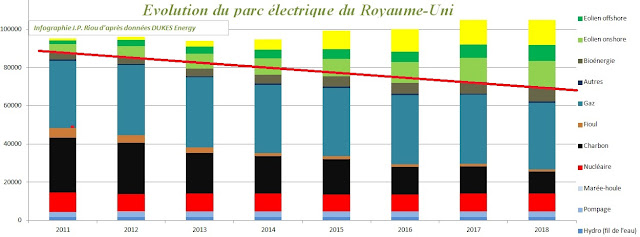Le système
électrique au Royaume-Uni
Les leçons d'un succès
Jean Pierre Riou
L’économiste
Guillaume Gaulier a publié quelques graphiques extrêmement révélateurs sur l’efficacité
des politiques énergétiques européennes. Chacun d’eux ne saurait montrer qu’un
aspect du problème, l’évolution du rapport entre émissions de CO2 et PIB en
base 100 depuis 2002 semble particulièrement pertinent.
Dans
cette comparaison, l’efficacité du Royaume-Uni se détache clairement de celle des autres
pays européens à partir de 2012.
Ce
qui justifie l’examen des mesures ayant permis ce succès.
Car
la sortie du charbon du Royaume-Uni est une réussite incontestable de sa
politique climatique.
Le
graphique ci-dessous montre sans équivoque l’effondrement de sa consommation à
partir de 2012.
Et
précise la part prépondérante de la production d’électricité (en gris) et sa
réduction drastique à partir de 2012.
Performance d'autant plus remarquable
que cette sortie du charbon du mix électrique s’est accompagnée d’une réduction
en termes de puissance pilotable installée, illustrée sous la ligne rouge du graphique ci-dessous.
Infographie : au 31
décembre de chaque année selon National
Statistics, Gov.UK 5-12
Ce
qui fait figure d’exception en Europe, où le formidable essor des EnRe
intermittentes (éolien/PV) n’a toujours pas
permis de réduire la puissance pilotable installée d’un seul MW.
Le
signal prix de la taxe plancher
Dans
son analyse, sur Le signal
prix du CO2, * RTE rappelle que « La gestion de l’équilibre entre l’offre et la demande d’électricité
repose sur une logique de préséance économique qui définit « l’ordre d’appel » et
montre qu’en l’absence de taxation du carbone, c’est le lignite qui serait
appelé prioritairement en raison de son faible coût marginal (5€/MWh), juste
après les EnR dont ce coût est nul.
Tandis
que celui du gaz, beaucoup moins émetteur, se situe entre 35 et 45€/MWh.
Le
système européen d’échange de quotas d’émissions (SEQE-UE), dont dépendent les
centrales électriques, est destiné à favoriser la compétitivité des centrales
les moins émettrices. Son taux demeure cependant trop bas pour être encore
efficace.
L’étude
montrait qu’en 2016, le taux actuel des quotas carbone (7€ la tonne)
n’empêchaient pas le lignite et même le charbon d’être plus compétitifs que le
gaz, et donc d’être appelés avant lui.
Toujours selon RTE, cette taxe
anglaise a eu le double effet antagoniste de réduire la production du charbon
anglais, mais aussi de dévaloriser les quotas carbone européens en augmentant
mécaniquement la quantité de quotas restant disponibles. Et, par la
même, de favoriser les émissions de CO2eq des autres pays.
D’autre
part, parmi les différentes mesures incitatives, le système de « Contract
for difference » (CFD) est considéré comme le levier le plus efficace pour soutenir
la production d’énergies bas carbone.
Il
est important de noter que le nucléaire britannique bénéficie de ce mécanisme
au même titre que les énergies renouvelables, ainsi que le rappelle l’analyse de l’Agence Internationale de l’Energie (AIE) (p 29).
Selon la Banque
Mondiale,
cette taxe plancher du Royaume Uni impose le plus fort taux au monde, avec celui de
l’Espagne, du Danemark et de l’Irlande, à 25$/tCO2eq en 2018, tandis que le
système d’échanges européens la taxait à 16$.
Cette
taxation a été déterminante dans la réduction spectaculaire des émissions de
CO2eq de la production électrique britannique. Tandis qu’en France, le projet
de prix plancher du carbone, annoncé depuis 2015, puis envisagé pour les seules centrales à charbon a été refusé du projet de loi de finance 2017.
La
baisse de la consommation
D’autre
part, le Royaume Uni a instauré une série de taxes environnementales dont
l’efficacité s’est manifestée par une forte réduction de la consommation. Selon
l’AIE,
la consommation d’électricité a en effet baissé de 12% entre 2007 et 2017 tandis
que la production baissait de 15% entre ces mêmes dates.
Le
recours accru aux importations
Le
développement des interconnexions a permis l’accroissement des importations, essentiellement
depuis la France (liaison de 2GW) et les Pays-Bas (1GW) augmentant
notamment de façon très marquée entre 2010 et 2015. Les importations depuis la France
ont marqué une nouvelle
hausse de 25% en 2018.
Notons
à ce sujet que Enerdata vient de publier ses statistiques 2019 qui confirment
la place de la France en tant que plus
gros exportateur mondial d’électricité, qu’elle détient quasiment chaque
année depuis 1990.
Ces éléments
doivent faire comprendre les 3 points suivants :
- L’exception
britannique de réduction de la puissance pilotable installée n’est pas transposable
à la France.
- Les
mesures incitatives doivent concerner toutes les solutions décarbonées,
y compris le nucléaire.
- Le
signal prix sur le carbone entraîne mécaniquement la réduction de ses émissions.
Pour
autant, les économistes considèrent que sa taxation doit
s’opérer à charge fiscale constante, grâce à la redistribution intégrale de
son produit vers les ménages.
Il
est d’autant plus regrettable que la France se prive la progressivité de ce
puissant levier en détournant
son produit vers le financement de l’éolien et du solaire, ce qui est d’autant
plus contre-productif que le mix électrique français est déjà
décarboné.
* Le lien de cette étude est malheureusement cassé, mais peut être retrouvé ici
Mise à jour du 05/02/2023
Malgré son caractère insulaire, la Grande Bretagne est connectée avec ses voisins, pour équilibrer son réseau électrique, particulièrement grâce aux importations depuis la France. Pour assurer des échanges appelés à augmenter en raison du caractère variable de son parc éolien, la Grande Bretagne a entrepris un renforcement considérable de ces interconnexions.
Le tableau du gestionnaire Eleclink reproduit ci-dessous en donne la mesure, soit 4000MW jusqu'à 2019 et 12100MWsupplémentaires à partir de 2019



















